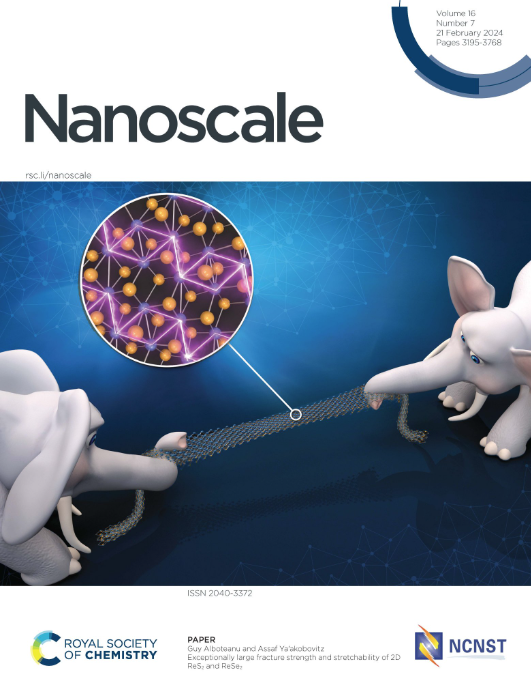Investigation of the phase transition to the Ruddlesden–Popper phase in La- or Nb-doped Sr2Fe1.5Mo0.5O6−δ double perovskites and the impact of lanthanum or niobium doping
IF 5.8
3区 材料科学
Q1 CHEMISTRY, MULTIDISCIPLINARY
引用次数: 0
Abstract
Sr2Fe1.5Mo0.5O6−δ (SFM) is a well-known representative of the double perovskite family, recognized for its remarkable properties, such as good conductivity in air and hydrogen. However, this material can undergo a phase transition under reductive atmospheres, which might be a challenge for its practical use. Herein, we focus on the impact of lanthanum or niobium dopants, which would not only stabilize the structure during the reduction but also have a beneficial impact on the properties of the material, e.g., electrical conductivity. As a result, lanthanum doping (LSFM – La0.3Sr1.7Fe1.5Mo0.5O6−δ) was found to be the most stable and the lowest amount of a new Ruddlesden–Popper phase was formed during the reduction. Moreover, the aliovalent La-doping resulted in increased electrical conductivities in both air and hydrogen compared to those of pristine SFM. Niobium doping resulted in a behavior similar to that of SFM with only slight stabilization, but the exsolution process in this material was found to be more intense. In situ studies during oxidation allowed us to retrieve the original structure at 700 °C. Ex situ XAS analyses enabled us to focus on the electronic state, which in most cases was restored almost to the original state after the re-oxidation process. This showed that not only the crystallographic structure but also the local atomic structure were re-established. The use of wavelet transform on the Fe K-edge allowed us to differentiate contributions from the Fe–Fe and Fe–Mo bonds in LSFM.

La或nb掺杂Sr2Fe1.5Mo0.5O6−δ双钙钛矿向Ruddlesden-Popper相转变及镧、铌掺杂影响的研究
Sr2Fe1.5Mo0.5O6−δ (SFM)是双钙钛矿家族中众所周知的代表,以其卓越的性能而闻名,如在空气和氢气中的良好导电性。然而,这种材料在还原气氛下会发生相变,这对其实际应用可能是一个挑战。在这里,我们关注镧或铌掺杂剂的影响,它们不仅会在还原过程中稳定结构,而且会对材料的性能(例如导电性)产生有益的影响。结果表明,镧掺杂(LSFM - La0.3Sr1.7Fe1.5Mo0.5O6−δ)最稳定,在还原过程中形成了最少数量的Ruddlesden-Popper相。此外,与原始SFM相比,共价la掺杂导致空气和氢气中的电导率增加。铌掺杂导致了与SFM相似的行为,只有轻微的稳定,但该材料的析出过程更为强烈。氧化过程中的原位研究使我们能够在700°C下恢复原始结构。原位XAS分析使我们能够专注于电子态,在大多数情况下,电子态在再氧化过程后几乎恢复到原始状态。这表明不仅晶体结构得到了重建,而且局部原子结构也得到了重建。在Fe - k边缘上使用小波变换使我们能够区分LSFM中Fe - Fe和Fe - mo键的贡献。
本文章由计算机程序翻译,如有差异,请以英文原文为准。
求助全文
约1分钟内获得全文
求助全文
来源期刊

Nanoscale
CHEMISTRY, MULTIDISCIPLINARY-NANOSCIENCE & NANOTECHNOLOGY
CiteScore
12.10
自引率
3.00%
发文量
1628
审稿时长
1.6 months
期刊介绍:
Nanoscale is a high-impact international journal, publishing high-quality research across nanoscience and nanotechnology. Nanoscale publishes a full mix of research articles on experimental and theoretical work, including reviews, communications, and full papers.Highly interdisciplinary, this journal appeals to scientists, researchers and professionals interested in nanoscience and nanotechnology, quantum materials and quantum technology, including the areas of physics, chemistry, biology, medicine, materials, energy/environment, information technology, detection science, healthcare and drug discovery, and electronics.
 求助内容:
求助内容: 应助结果提醒方式:
应助结果提醒方式:


